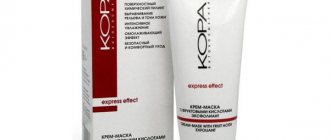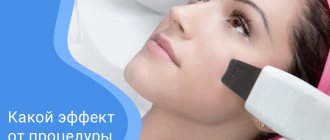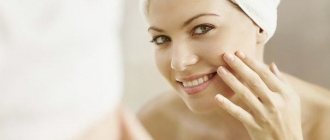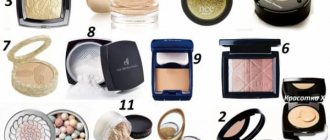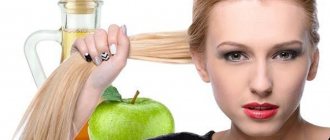Description of peeling
The apple contains many useful trace elements, minerals and various polyphenols, pectins, vitamins and other substances, so it is considered one of the healthiest fruits for humans. One of the substances included in its composition is apple cider vinegar, the properties of which make it possible to successfully use cosmetic preparations made from apples to cleanse the skin.
The effect of apple cider vinegar on the skin has an astringent, drying and soothing effect; when applied to the skin, old cells are exfoliated and young cells are intensively regenerated.
In general, apple peeling is a special case of fruit peeling, in which the concentration of malic acid, among other fruit acids, is 10%-15%. At the same time, peeling with malic acid is characterized by moderate results in smoothing out deep wrinkles and scars, but effectively helps in polishing and evening out the complexion and increasing the firmness and elasticity of the skin.
Properties of the active component
The active ingredient, as mentioned above, is malic acid.
(aka malonic acid, hydroxysuccinic acid, E296, malic acid). It is obtained from fruits (unripe apples, grapes, rhubarb, rowan fruits, barberries, gooseberries and raspberries) or synthetically.
Malic acid is an intermediate metabolic product in living organisms. In the glyoxylate and tricarboxylic acid cycles and during gluconeogenesis, malic acid is formed in the form of malate. Under the influence of enzymatic reactions, malate can be converted into oxaloacetate, fumarate, and pyruvate.
Action of malic acid:
1. antioxidant 2. capillary strengthening 3. keratolytic 4. hydration 5. immunostimulating 6. Bacteriostatic and anti-inflammatory 7. Regenerative 8. restores the lipid layer of the skin.
Malic acid is found in apple cider vinegar, which is widely used for at-home peeling. Apple cider vinegar is an excellent acidity regulator for the skin. By noticeably shifting its acid-base balance towards increasing acidity, it demonstrates antibacterial properties, creating conditions that suppress the activity of harmful bacteria, viruses and fungi. This way you can get rid of skin irritation and inflammation. At the same time, restoration of the acid-base balance of the skin and its natural protective functions after the apple peeling procedure occurs in a short time (in most cases, no more than one week) by itself. Exposure to apple cider vinegar also leads to the disappearance of acne and clearing of pores.
Apple cider vinegar contains a large number of amino acids, so it helps to launch mechanisms of intensive cell regeneration, increased collagen production, protection from the harmful effects of free radicals, as well as replenish the deficiency of useful substances in skin cells, including vitamins (A, B1, B2, B6 , C and E), acids (lactic, citric, malic, oxalic), trace elements (potassium, calcium, magnesium, sodium, iron, silicon, copper, sulfur, phosphorus) and enzymes.
Indications and contraindications
Indications
1. Hyperpigmentation 2. Chrono and photoaging 3. rosacea and telangiectasia 4. General skin atony (flabby, flabby and sagging skin) 5. Hyperkeratosis (slow process of exfoliation of cells of the stratum corneum) 6. Mild form of acne to soften comedones and normalize sebum secretion
Contraindications
1. Allergy to one of the components of the peeling composition 2. Herpes in the acute stage 3. Pregnancy and lactation 4. Damage to the skin 5. Neoplasms 6. Skin diseases 7. Acute inflammatory diseases 8. Chronic diseases in the acute stage
Pros and cons compared to other types of peeling
pros
One of the main advantages of apple peeling is the ability to use it at any time of the year. It is useful and effective for any age group, is used for people with problematic and sensitive skin, and is indicated for rosacea.
Apple peeling contains no mechanical abrasives. The cleansing process occurs due to the softening of the bonds between the cells of the stratum corneum and the epidermis, which is a consequence of the effects of acid.
Apple peeling effect
1. Complexion is evened out, redness is removed 2. Pigment spots are reduced 3. The acidic pH of the skin is restored 4. Small wrinkles are smoothed out 5. The skin becomes smooth and soft 6. Skin turgor and elasticity increases
Minuses
Since apple peeling is light, superficial, it has a less pronounced effect compared to other peels (glycolic, salicylic), it will not remove wrinkles and scars.
Mechanical cleaning
Indications for it are severe sebaceous glands, an increased number of comedones or acne, and a tendency to frequent inflammation. It is done manually, without machines. First, the face is steamed using hot compresses or special masks. Then the cosmetologist treats the skin with antiseptics and squeezes out the contents of the pores one by one using special metal spoons. This is the method recommended for people with oily and problematic skin. After cleansing, the face is disinfected with an anti-inflammatory composition. The whole process takes from one to one and a half hours. After the procedure, it is recommended not to use decorative cosmetics and not sunbathe for 4-5 days.
Preparation of apple peeling
Homemade apple cider vinegar is the most effective.
In this case, you can guarantee the presence of beta-carotene, which is a natural antioxidant that neutralizes free radicals, as well as vitamins, amino acids, pectins and enzymes. There are several recipes for making apple peeling at home. For example, apple cider vinegar is diluted in water in a ratio of 1:8 and cloves and lavender are added. The resulting mixture is infused for a week in a dark place, with occasional shaking. The resulting peeling solution is stored at low temperature (in the refrigerator). You can also use honey (1 tablespoon), fine salt (1 teaspoon) and apple cider vinegar (1 tablespoon) to prepare apple peeling. All these components are mixed and the resulting mixture is immediately ready for the procedure. Another simple recipe for making an apple peel that is immediately usable is to mix two tablespoons of apple cider vinegar with 0.5 liters of water. In addition, many cosmetic companies produce ready-made apple peels. In many cases, they are made with the addition of various auxiliary substances that improve the effectiveness and expand the range of action of the procedure. For example, sugar cane and maple fruit extract moisturize and achieve a calming effect, while deeper cleansing is provided by extracts of papaya, orange, gypsophila root and blueberry, a calming effect due to calendula flowers, and an antioxidant effect due to the addition of wild apple extract.
Acids and their concentration
For comprehensive care, combinations of several acids are used, so the product covers several directions at the same time. It is taken into account that epidermal cells get used to some acids in everyday life: glycolic, lactic. To them is added one that will make a breakthrough, activate and accelerate metabolic processes.
Lemon
It is an antibacterial agent, destroys harmful microorganisms on the surface of the skin, and moderately whitens it. Used diluted. In addition to lemon and lime, it is found in other citrus fruits, kiwi.
Glycolic
The substance HOOC-CH₂-OH is responsible for pigmentation, returning an even tone and correct structure. The pores narrow, pigment spots gradually disappear. Its sources are sugar cane and beets, unripe grapes.
Apple
In biology - hydroxysuccinic acid. Stimulates metabolic processes, causes cells to renew themselves at a rapid pace. In addition to apples, it is produced from rowan, barberry, and raspberries. Unripe fruits and berries are especially rich in the component.
Dairy
The second name is lactate. It is a fermentation product, therefore it is found in fermented milk drinks (kefir, yogurt), and blueberries. The size of the molecule allows it to easily pass through cell membranes, and deep hydration occurs. As a result, the surface softens and becomes more delicate.
Wine
It is a dibasic hydroxy acid, the main enemy of keratinized cells, exfoliates, removes old particles of the integument. Whitens, moisturizes. Based on the name, it is found in wine and grapes. It is also extracted from oranges and the sour juices of other fruits.
A standard set of components will improve the health of the epidermis, the proportions vary depending on the goal.
Pre-peeling preparation
The first stage of pre-peeling preparation of facial skin for the procedure is makeup removal and cleansing of the skin. To do this, use a cleansing foam or gel for washing. Then the skin is degreased and toned using lotion according to skin type. When using peeling at home (low malic acid content), you can steam your face to facilitate the process of removing dead skin. To do this, you can direct a stream of hot water from the shower into your face or use a terry towel soaked in hot water and slightly wrung out - it is applied to your face and left for 30 seconds. This procedure is performed several times until the skin is moderately steamed.
How does the peeling procedure work?
The superficial peeling procedure with fruit acids usually takes about 30 minutes and consists of several stages:
- First, the cosmetologist thoroughly cleanses the skin and prepares it for peeling using special products.
- Then a thin layer of acid is applied to the face, usually in the form of a gel, and left on the skin for an average of 2 to 10 minutes. At this time, as a rule, a slight tingling or slight burning sensation is felt.
- After this, if necessary, a neutralizer is applied to the skin for 2-3 minutes, which stops the peeling.
- Then everything is washed off and post-peeling cream is applied.
Stages of apple peeling
In salons, apple peeling most often includes other soft fruit acids (mandelic and lactic), the total acid content is about 25%. The peeling mixture is applied with a fan brush to the face, neck and area around the eyes. Exposure time 10 minutes. Then neutralization is carried out according to the protocol using a special alkaline agent or water).
Apple peelings for home use are presented in the form of gommage. Peeling gommage is applied in an even thin layer to the skin of the face and neck, except for the paraorbital zone and the lip area. When the composition dries (after about 1-2 minutes), you need to roll the gommage into pellets with light circular movements. You should start applying the product from the chin area along the massage lines upward. To do this, apply a small amount of peeling from the tube to your fingers, lightly stretch the skin with one hand, and use the middle and ring fingers of the other to make circular movements. When you have rolled up all the product, wipe your face with warm water and toner.
Another way to perform the procedure is to apply a cotton or linen napkin soaked in self-prepared apple peeling to your face. In this case, the area of their contact should be maximum. This operation is repeated for normal skin for 10 - 15 minutes at intervals of 1 - 2 minutes. Oily, porous skin requires a longer procedure, while dry and sensitive skin requires a minimum number of operations. The final step is to wash your face with warm water and massage it with a terry towel along the massage lines with light movements to finally free the surface of the skin from dead cells. After this, the face is rinsed generously with water, lightly blotted with a towel and moisturizer is applied to it. The slight redness of the face that occurs after the procedure completely disappears after 20 minutes.
The final step in all cases is to apply cream according to your skin type and it is advisable to use a sunscreen with SPF of at least 20.
Number of procedures
The frequency of the procedure for oily and normal skin is 2 times a week, and for dry and sensitive skin – 1 time a week. A course of 10-15 procedures.
Popular means
A consultation with a cosmetologist or cosmetics seller will allow you to choose medications for independent use. Information about each of them will indicate the differences and determine the one you need.
- Janssen Inspira MFA from the German brand Janssen Cosmeceutical comes in classic white packaging. The manufacturer additionally offers a care kit. The biocomplex of fruit acids is a good basis for moisturizing and working with relief;
- Skinlite (South Korea) is often used at home: the delicate effect prevents irritation, while softening the epidermis, the face becomes softer and fresher;
- “Bark” cream mask contains AHA acids, allantoin, and D-panthenol. Oily shine is eliminated and pores are narrowed. Sold in a pharmacy. A standard 100 ml package lasts for about a year. Attention, the product cannot be used during pregnancy; those with sensitive skin should apply the mask carefully;
- Meishoku Detclear bright & peel aha & bha fruits uses a Japanese formula to combat dry skin without the risk of burning.
Possible complications after apple peeling
When using apple peeling on dry skin, there is a high probability of it drying out, so throughout the course you should carefully monitor the condition of the skin and use moisturizers. Apple peeling is superficial and does not cause serious complications; no peeling is observed. In rare cases, dry, sensitive and thin skin may cause slight flaking in the cheek area, itching and red spots. You should use a series of cosmetics for sensitive skin prone to irritation in your home care.
Facial hyperemia is possible, which goes away on its own for the first few hours after peeling. Creams with soothing ingredients should be used. An exacerbation of herpes is also possible. Prophylaxis should be carried out before performing the procedure.
Also, do not forget about the intolerance of some skin types to acids. To determine this, apply a small amount of peeling to a sensitive area of skin, such as the wrist, and wait a couple of minutes before rinsing. If redness or irritation occurs in this area, it is better to avoid using apple peeling. If it gets into your eyes, rinse them immediately with water. If the recommended dosage or exposure time is exceeded, peeling, itching and red spots may occur.
Prices and brands of peelings
The cost of an apple peel will depend on where you will peel it - in a salon or at home. In the salon, you will pay on average from 2000 to 3500 rubles for one procedure. For home use, you can purchase apple peels from different companies; the cost of one jar or tube varies on average from 220 to 600 rubles. The effect of home peelings is much less than that of salon procedures, since they contain a minimal percentage of acid.
Manufacturers of apple peeling
Home series:
1. Apple peeling gel gommage - Apple juicy peeling gel, Mizon (Korea)
2. Massage cream (peeling roll) “Green Apple” - Appletox Smooth Massage Peeling Cream, Tony Moly (Korea)
3. Apple peeling gel - Vov-Apple AHA Peeling gel, VOV (Korea)
4. Peeling roller “Universal Apple” - Spa Technology TianDe, Great Wall Cosmetics Factory (China)
5. Peeling gel with green apple extract - Apple All in One Peeling Gel, Baviphat (Korea)
6. Peeling Green Apple for sensitive skin - Green Apple Peel - Sensitive, Juice Beauty (USA)
Salon peelings:
1. Radiant peeling – Illuminize Peel (Skinmedica, USA)
2. AHA Almond-Apple Peeling 25% – Almond/apple pell lotion, Eldan Cosmetics (Switzerland)
Tags: peeling
Market Analytics
- Global cosmetics market 2022: an unprecedented test for the global cosmetics industry
- Top 10 Cosmetic Research and Development of 2022
- 2020 in the beauty industry – innovation without borders
Convenient search for beauty salons on our website
Beauty salons in Moscow Beauty salons in St. Petersburg Beauty salons in Ekaterinburg Beauty salons in Novosibirsk
Latest blog posts on our website
- Naturecream / Properties of the “Sunny” oil itself
- Naturecream / “Sugar” wrinkles - or what glycation can do
- Naturecream / Esterified oils
- Naturecream / Arnica - the magical plant of alchemists
- Naturecream / Tremella Extract - Snow Mushroom Detox for Skin
- Prostye-sovety / How to visually enlarge your lips with makeup
- Naturecream / Apricot kernel oil for face
- Naturecream / MATRIXYL3000 - the best skin elasticity stimulator
- Naturecream / SPF in Natural Oils
- Naturecream / Geranium (Pelargonium) oil for skin health and beauty
Latest forum topics on our website
- Natalya / How to properly make a gelatin mask?
- Mrs._Smith / Badly sunburned! What to do?((
- Ice / Is it necessary to combine fitness classes with a diet?
- Antonova / What can be used for hair loss?
- Radio operatorKat / Who was on a protein diet?
Reviews about the procedure
Apple peeling for the face [Leave a review]
Leave your feedback about this procedure (it will appear on this page after moderation)
In this form, describe only
your personal
experience of undergoing the procedure.
In order to leave a comment regarding the content of the article, use another form - in the “comments” block at the bottom of the page.
Other articles in this section
| Salicylic peeling for the face Salicylic peeling has a powerful anti-inflammatory, antiseptic and keratolytic effect, it helps to normalize the functioning of the sebaceous glands and narrow pores. This peeling is indicated for young oily skin with minor problems, as well as for mature skin with signs of photo- and bioaging. |
| Alpha-peptide facial peeling Alpha-peptide peeling refers to chemical peels of superficial or medium action, depending on the concentration of alpha hydroxy acids and pH level. Alpha peptide peeling is specially designed for aging skin with age-related changes. This type of peeling promotes the renewal of dermal and epidermal cells, reduces the visibility of deep wrinkles, disappears superficial ones, and also has a good lifting effect and moisturizing. |
| Enzyme (enzyme) peeling for the face Enzyme peeling is a superficial peeling in which the active substance is not acids, but enzymes. Enzyme peeling is a fairly gentle procedure suitable for all skin types, including sensitive skin with rosacea. |
| Ultrasonic peeling or ultrasonic facial cleansing Ultrasonic peeling is a procedure that provides hardware facial cleansing, exfoliation, and renewal of the surface layers of the skin under the influence of high-frequency vibrations. This procedure is also called ultrasonic facial cleansing. Experts recognize ultrasonic peeling as one of the mildest types of cleansing, which allows you to remove only the superficial layers of the epidermis, eliminate acne and dirty comedones, smooth out wrinkles, improve hemodynamics, provide natural hydration and lifting. |
| Laser skin resurfacing Facial skin resurfacing (dermabrasion) is a deep peeling procedure during which the epidermis and part of the dermis are completely removed. One of the progressive methods of skin resurfacing is to carry out this procedure using a laser. In this case, its radiation leads to complete evaporation and coagulation of soft tissue to the required depth. |
| Phenol peeling for the face Phenol peels refer to skin exfoliation procedures performed using carbolic acid (phenol). Deep peeling affects all layers of the epidermis, right down to the papillary layer. The extreme length of the rehabilitation period, reaching 12 months in some cases, and the high risk of severe complications require a particularly careful approach. |
| Glycolic peeling for the face Currently, glycolic peeling is a very common cosmetic procedure. Being one of the types of superficial chemical peeling, it primarily helps to cleanse the upper layer of the skin from dead stratum corneum, while simultaneously leveling its relief by reducing the thickness of the stratum corneum, while the thickness of the living layers of the epidermis increases, and pigmentation in areas excessively stained with melanin is normalized ( freckles, age spots). |
| Arginine peeling for the face One of the types of chemical peelings is arginine peeling, which rejuvenates and moisturizes the skin, has a mild exfoliating effect, and prevents the appearance of the inflammatory process. The result is already visible after the first procedure. The skin becomes velvety, matte, elastic, and a healthy complexion appears. |
| Peeling with gluconolactone for the face Peeling with gluconolactone is a relatively new type of superficial chemical peeling. It has more pronounced moisturizing properties compared to AHA. The gluconolactone molecule penetrates the structure of the skin more slowly, which avoids the burning sensation that often appears when using other active ingredients. Therefore, peeling with gluconolactone is recommended for people with very sensitive skin. |
| Wine peeling for the face Wine peeling is a cosmetic procedure for treating the skin with a composition with a high concentration of acids, an acetic complex and components of plant origin, which determines its high efficiency. It belongs to the group of superficial and soft medium peels. The excellent results of this procedure are expressed in the stimulation of exfoliation and renewal of the epidermis, as well as the activation of the processes of getting rid of damaged collagen and elastin fibers and the formation of new fibers. |
Recommendations for fruit peeling
A product based on fruit acids appeared in the cosmetics industry relatively recently. But thanks to its effectiveness, it quickly gained popularity among women. Today, fruit peeling is actively used by millions of fans in beauty salons and at home.
The procedure has no age restrictions and quite a few contraindications. Peeling based on fruit acids is indicated for older women, since over the years the epidermis renews itself more and more slowly. Chemical stimulation helps maintain skin tone and health.
In adolescence, fruit peeling fights acne and increased oiliness. From 20 to 30 years - counteracts dryness, eliminates blackheads, peeling, pimples, uneven skin texture. From the age of 35, peelings with fruit acids help rejuvenate the face. And from 45 - they are a preparatory stage for many salon procedures.
Fruit peeling at home is carried out if the following problems exist:
- age spots on the face;
- acne;
- small scars, cicatrices or post-acne;
- small age wrinkles;
- hyperkeratosis (excessively thick stratum corneum).
To solve a specific problem, it is better to contact an experienced cosmetologist. The specialist will tell you what type of acid and in what concentration is needed. Often home treatments are sufficient, but in some cases a deeper peeling is required, which is done in salons.
